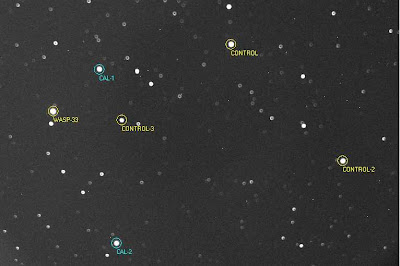 WASP-33 es la primera ocasión en que se han observado pulsaciones fotométricas no estelares en una estrella con un exoplaneta orbitando alrededor suyo.
WASP-33 es la primera ocasión en que se han observado pulsaciones fotométricas no estelares en una estrella con un exoplaneta orbitando alrededor suyo.Eso ha dado lugar a unas curvas fotométricas muy peculiares, que permiten afirmar la existencia de interacciones de marea entre la estrella y su exoplaneta, un gigante gaseoso. Entre las posibles causas se apunta a la existencia de una órbita excéntrica, la distorsión de la estrella por la onda de marea, o incluso que la estrella sufra intrísecamente esas variaciones pulsantes y haya fijado posteriormente la órbita planetaria.
El hallazgo es interesante además, porque se ha hecho en colaboración con el Observatorio de Montcabrer regentado por Ramón Naves que aparece como co-autor en el artículo enviado a ArXiv el 7 de octubre de 2010 (ver más abajo). Ramón es también colaborador habitual del foro ALKAID,
 WASP-33 is the first case where non-solar like photometric pulsations have been observed on a known transmiting exoplanet host star.
WASP-33 is the first case where non-solar like photometric pulsations have been observed on a known transmiting exoplanet host star.
This has originated very unusual photometric curves, allowing to think in the existence of tidal interactions between the exoplanet, a gaseous gigant, and its host star. Among the possible causes are an eccentric planetary orbit, the distortions of the star sahpe by the tidal wave, or that the star had these inherent pulsations cuasing the locking of the planetary orbit.
The finding is very interesant because has been made in collaboration with the amateur Montcabrer Observatory run by Ramon Naves, who appear as co-author in the scientific paper sent to a ArXiv in October 7, 2010 issue (see below). Ramon is also a habitual collaborator to the ALKAID forums.
Resumen/Abstract
WASP-33: The first delta Scuti exoplanet host star and evidence of star-planet interactions
E.Herrero, J.C.Morales, R.Naves,and I.Ribas
Astronomy&Astrophysics, Octiber 7, 2010
We report the discovery of photometrico scillations in the host star of the exoplanet WASP-33b(HD15082). The data were obtained in the R band both in transit and out-of-transit phases from the Montcabrer(0.3-m telescope) and Montsec(0.8-m telescope) observatories. Proper fitting and subsequent removal of the transit signal reveals stellar photometric variations with an amplitude of about 1mmag and a period of 67.57±0.08 min, which is typical of delta Scuti-type variable stars.Furthermore, the oscillation period is commensurable with the orbital period of the planet with a factor of 26. These findings make WASP-33the firs ttransiting exoplanet host star with pulsation variability and possibly experiencing tidally induced planet-star interactions. Several possible explanations for the existence of the observed high-order ressonance such as perturbations due to an eccentric orbit, rotational distortion of the star or tidal locking during planet migration are proposed.
La publicación completa/The full paper
No hay comentarios:
Publicar un comentario